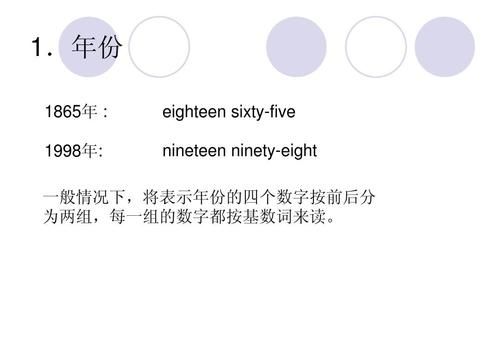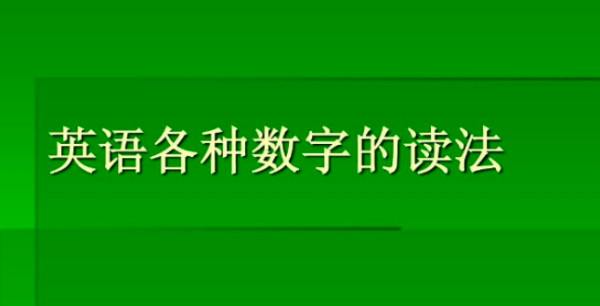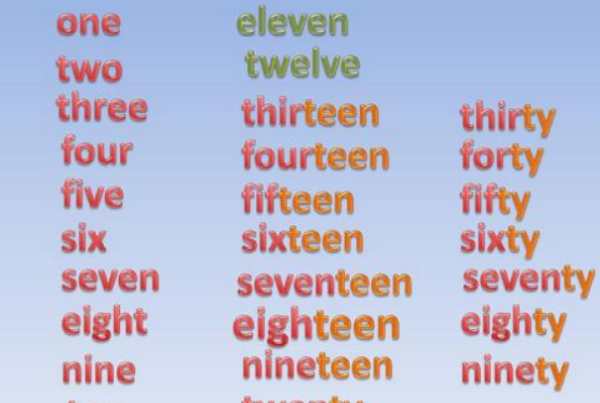本文目录
英语中大数字的读法和写法
我们的数字读法是四个零四个零分开读,如万,亿,小一点的有单独读法,千,百,十。英语中是三个零三个零分开读,即千的次方,如thousand(千),million(百万),billion(十亿)。读法为从大到小,数字从左到右,把数字从个位开始三个三个分开,中间用逗号连接,百位和十位用and连接,十位和个位用短横线“-”连接。举个例子:99 999 999的读法为ninety-nine million,nine hundred and ninety-nine thousand,nine hundred and ninety-nine.

英语中的十位,个位,百位,千位,万位分别怎么读呢
1、one— first (第一)
2、two―second(第二)。
3、three— third(第三)
4、four-fourth(第四)。
5、five―fifth (第五)。
6、six―sixth (第六)。
7、seven―seventh (第七)。
8、eight―eighth (第八)。
9、nine―ninth (第九)。
10、ten―tenth(第十)。

扩展资料
1、3-4位的数字读法:
英语中有“百”和“千”的计数单位,所以直接用数字+计数单位+数字就可以。比如:105 读作 one hundred (and) five,245 读作 two hundred (and) forty-five,3,286 读作 three thousand two hundred (and) eighty-six。
2、四位数字也可以读作thirty-two, eighty-six,也就是说两个两个的读出来。
3、 5-6位的数字读法:
处理5位以上的数字时,我们要记得看“逗号”,因为三个数字一个逗号,即三位一节,把三位看成一个整体,后面再加一个单位。5位的数字在汉语中可以用“万”来表示,6位即是“十万”,在英语中却没有相应的单位词。
英语中数字的读法规则百度文库PPT
英语中数字的读法规则如下:

1到20之间,直接读单个的数字;读大于20的数字,先读十位数再读个位数:7-seven,32-thirty-two,89-eighty-nine;当表达大于100的数字时,以“百”为单位来读,顺序为十亿、百万、千、百。

Expressing numbers in English can be confusing to both students and those listening. Make sure you understand how to express numbers in spoken English by following these rules.
用英语表达数字,无论是对学生还是听者来说都是容易令人困惑的。通过遵循以下这些规则,可以确保你懂得如何用英语表达数字。
Below you will find numbers written out in order to helps students learn the correct grouping in English. Generally speaking, numbers larger than twenty should always be expressed by numbers in written English:
你会发现下面写出的数字是为了帮助学生学习正确的分组。一般来说,大于二十的数在书面英语中应该用数字表示:
I have fifteen clients in New York.
我在纽约有十五个客户。
She has 240 contacts on her mailing list.
她的邮件列表上有240个联系人。
Tens
十位数
Say individual numbers between one and twenty. After that, use the tens (twenty, thirty, etc.) followed by the numbers one through nine:
一到二十之间,我们读单个的数字。二十往后,使用十位数(二十,三十等),紧接数字一到九:
7 - seven
19 - nineteen
英语中各种数字的读法
一、数字1:one;英[wʌn],美[wʌn]。
二、数字2:two;英[tu:],美[tu]。
三、数字3:three;英[θri:],美[θri]。
四、数字4:four;英[fɔ:(r)],美[fɔr]。
五、数字5:five;英[faɪv],美[faɪv]。
六、数字6:six;英[sɪks],美[sɪks]。
七、数字7:seven;英[ˈsevn],美[ˈsɛvən]。
八、数字8:eight;英[eɪt],美[et]。
九、数字9:nine;英[naɪn],美[naɪn]。
十、数字10:ten;英[ten],美[tɛn]。
十一、数字11:eleven;英[ɪˈlevn],美[ɪˈlɛvən]。
十二、数字12:twelve;英[twelv],美[twɛlv]。
十三、数字13:thirteen:英[θɜːˈtiːn],美[ˈθɜːtiːn]。
十四、数字14:fourteen:英[fɔːˈtiːn],美[ˈfɔːtiːn]。
十五、数字15:fifteen:英[fɪfˈtiːn],美[ˈfɪftiːn]。
十六、数字16:sixteen:英[sɪksˈtiːn],美[ˈsɪkstiːn]。
十七、数字17:seventeen:英[sev(ə)nˈtiːn],美[ˈsev(ə)ntiːn]。
十八、数字18:eighteen:英[eɪˈtiːn],美[ˈeɪtiːn]。
十九、数字19: nineteen:英[naɪnˈtiːn],美[ˈnaɪntiːn]。
二十、数字20:twenty:英[ˈtwentɪ],美[ˈtwentɪ]。

扩展资料
英语中的年份、日期的读法:
一、年份
关于四位数年份的读法有下列几种情形:
1、一般情况下,将表示年份的四个数字按前后分为两组,每一组的数字都按基数词来读。例如:1865年读作 eighteen sixty-five。
2、如果前两个数字为非“零”数字,后两位数分别为“零”,则先读出前两位数,然后将后面的两个“零”读为 hundred。例如:1900年读作 nineteen hundred。
3、第三个数字为“零”(其他数字不是“零”)的年份的读法应当将该“零”读为O[u]。例如:1809年读作 eighteen O nine。
二、日期
英语中年、月、日的表达方法是“月份+序数词,年”。2001年4月2日应该写成:April 2nd, 2001,读成:April the second, two thousand and one。
通常情况下,序数词是在基数词后加-th,但有几种特殊情况,可按下面规律来记:1、2、3单独记(即first, second, third),8后少t,9少e(即:eighth, ninth),5、12变ve为fth(即fifth, twelfth),整十位数变y为ie再加th(如twentieth),二位以上只将个数变序数词(如thirty-second)。
例如:October 31(October 31st)读作October(the)thirty-first。
以上就是关于英语多位数字的读法规则,英语中大数字的读法和写法的全部内容,以及英语多位数字的读法规则 的相关内容,希望能够帮到您。

